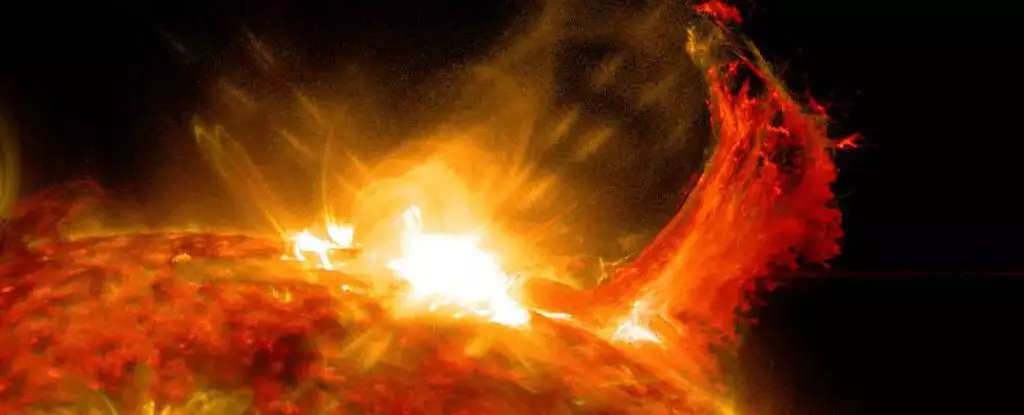The sun, often regarded as a cornerstone of life on Earth, is a complex entity, teeming with unpredictable behavior and explosive energy. Recent studies reveal a startling potential for catastrophic solar events, indicating that our star is not as benign as it seems. Scientists have long debated how often these dramatic phenomena—known as superflares—occur, and recent analysis suggesting a superflare every 100 years raises significant concerns. This article dissects the implications of such discoveries and the corollary effects on life as we know it.
Solar activity manifests through several dynamic processes, primarily driven by convection currents and magnetic field interactions. The surface of the sun is in constant turmoil, displaying flares that eject vast amounts of energy into space and coronal mass ejections (CMEs) that can disrupt entire solar systems, including ours. While many of these events are harmless, an occasional superflare can unleash such destructive power that the consequences for Earth could be dire. Previous estimates placed these devastating events on a scale that varies from once per century to once per millennium, offering little reassurance about our vulnerability.
A new comprehensive study involving 56,400 sun-like stars suggests that the sun’s superflare frequency might be at the lower estimate of once every century. This rate of occurrence is alarmingly frequent, especially when considering that the infamous Carrington Event of 1859, which caused global disruptions, was only a fraction of a superflare’s potential intensity. The implications of this study are profound and necessitate a reassessment of how we understand solar dynamics.
Understanding the occurrence of solar superflares is not straightforward. The methods available for scientists are limited, primarily relying on indirect evidence gathered from historical records, including tree rings that reveal spikes in carbon-14, and nitrogen levels in polar ice cores. These records offer hints but often lack the clarity needed for a thorough understanding of solar activity.
To cast a wider net in their research, scientists have turned their attention to neighboring stars similar to the sun—specifically G-type yellow dwarfs. By observing these stars and their flare activity, researchers can infer the potential rates of solar superflares. However, an inherent challenge arises in measuring the rotation speeds of these stars, which is believed to correlate with flare activity. This lack of rotational data creates gaps in the conclusions drawn about sun-like stars’ behavior.
The recent research led by astronomer Valeriy Vasilyev aims to remedy this issue by analyzing a substantial sample of stars, focusing on their brightness and temperature, while accommodating for stars with unknown rotational data. They determined that sun-like stars exhibit a superflare rate of approximately once every century. This discovery compels us to confront the reality of a potentially volatile cosmic environment.
Historical records reveal that the sun has a history of intense activity. The Carrington Event is perhaps the most notable, causing widespread telegraph outages and even fires. Beyond that event, studies have uncovered at least nine geomagnetic storm events, dubbed Miyake events, that surpass the Carrington Event’s intensity within the past 15,000 years. These occurrences remind us that extreme solar activity is not an anomaly but rather part of our sun’s natural behavior, complicating our defenses against such cosmic disturbances.
While superflares can lead to disastrous geomagnetic storms, they also have less dramatic but still significant effects. Solar flares can disrupt high-frequency radio communications by altering the ionosphere, the layer that affects how radio waves travel. The relationship between solar flares and CMEs remains a subject of inquiry, raising questions about whether all large flares are accompanied by CMEs or if they exist independently.
Given the potentially devastating consequences that a superflare could unleash upon our planet, scientists stress the importance of enhanced surveillance and forecasting capabilities. As the astrophysicist Natalie Krivova points out, the recent findings offer a sobering reminder of the sun’s volatile nature. If we are to effectively mitigate the risk posed by these significant solar events, a deeper understanding of the sun’s mechanisms is vital.
Our reliance on technology makes us increasingly susceptible to the repercussions of solar activity. A greater knowledge base could enable effective forecasting, which is essential for implementing preventive measures to safeguard critical infrastructure against the potent impacts of superflares and related solar phenomena.
The sun remains an unpredictable force, and new evidence regarding its superflare frequency invites both concern and the need for proactive measures. As we continue to explore our celestial neighbor, a collaborative effort to enhance our understanding is not just prudent—it is essential for the protection of life as we know it on Earth.

